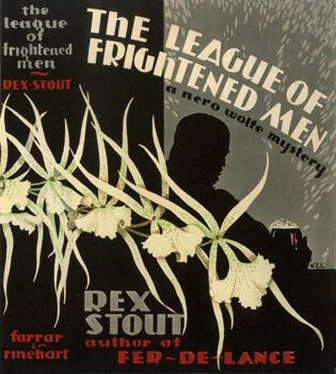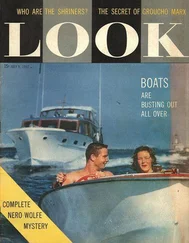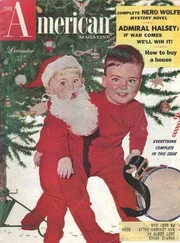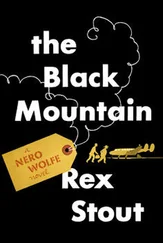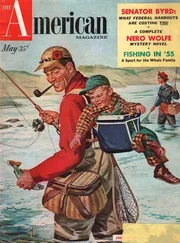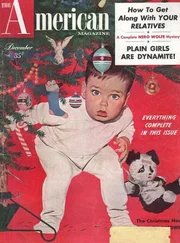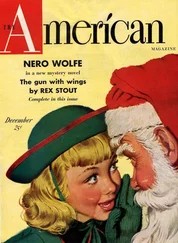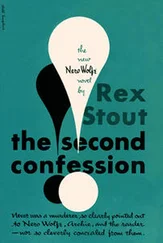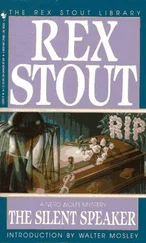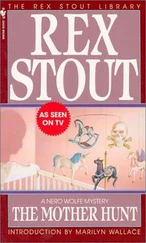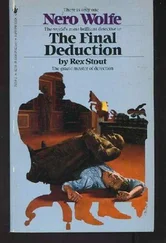My date with Elkus that Wednesday morning was for nine-thirty, but I made an early start because I wanted to stop off at Fifty-sixth Street for a look at the Dreyer gallery where it had happened. I got there before nine. It wasn’t a gallery any more, but a bookstore. A middle-aged woman with a wart in front of her ear was nice to me and said of course I could look around, but there wasn’t much to be made of it because everything had been changed. The little room on the right, where the conference had taken place on a Wednesday evening and the body had been found the following morning, was still an office, with a desk and a typewriter and so on, but a lot of shelves had been put in that were obviously new. I called the woman over and she came in the office. I pointed at a door in the back wall and said:
“I wonder if you could tell me. Is that the closet where Mr. Eugene Dreyer kept the materials for mixing his drinks?”
She looked hazy. “Mr. Dreyer... oh... that’s the man...”
“The man that committed suicide in this room, yes, ma’am. I suppose you wouldn’t know.”
“Well, really...” She seemed startled. “I hadn’t realized it was right in this little room... of course I’ve heard about it...”
I said, “Thank you, ma’am,” and went back to the street and got in the roadster. People who quit living a year ago Christmas and haven’t found out about it yet give me a pain, and all I’ve got for them is politeness and damn little of that.
Leopold Elkus hadn’t quit living, I discovered when I got to him in his private room, but he was a sad guy. He was medium-sized, with a big head and big hands, and strong black eyes that kept floating away from you, not sideways or up or down but back into his head. He invited me to sit down and said in a friendly soft voice:
“Understand, Mr. Goodwin, I am seeing you only as a courtesy to my friends who have requested it. I have explained to Mr. Farrell that I will not support the enterprise of your employer. Nor will I lend any assistance.”
“Okay.” I grinned at him. “I didn’t come to pick a scrap, Dr. Elkus. I just want to ask some questions about September nineteenth, when Eugene Dreyer died. Questions of fact.”
“I have already answered any question you could possibly put. To the police several times, and to that incredibly ignorant detective...”
“Right. So far we agree. Just as a matter of courtesy to your friends, there’s no reason why you shouldn’t answer them once more, is there? To converse with the cops and Del Bascom and then draw the line at Nero Wolfe and me... well, that would be like...”
He smiled a sad smile. “Swallow a camel and strain at a gnat?” God that guy was sad.
“Yeah, I guess so. Only if you saw Nero Wolfe you wouldn’t call him a gnat.—It’s like this, Dr. Elkus. I know you won’t lend a hand to get the goods on Paul Chapin. But in this Dreyer business you’re my only source of firsthand information and so I had to get at you. I understand the other man, the art expert, has gone back to Italy.”
He nodded. “Mr. Santini sailed some time ago.”
“Then there’s only you. There’s no sense in my trying to ask you a lot of trick questions. Why don’t you just tell me about it?”
He smiled sad again. “I presume you know that two or three of my friends suspect me of lying to shield Paul Chapin?”
“Yeah. Are you?”
“No. I would neither shield him nor injure him, beyond the truth.—Here is the story, Mr. Goodwin. You know, of course, that Eugene Dreyer was an old friend of mine, a classmate in college. He was pretty successful with his art gallery before the depression. I bought things from him occasionally. I have never been under the necessity of pursuing success, since I inherited wealth. My reputation as a surgeon is a by-product of my conviction that there is something wrong with all human beings, beneath the surface. By chance I have a sure and skillful hand.”
I looked at his big hands folded on his lap, and nodded at his black eyes floating back into his head. He went on:
“Six years ago I gave Eugene Dreyer a tentative order for three Mantegnas — two small ones and a larger one. The price was one hundred and sixty thousand dollars. The paintings were in France. Paul Chapin happened to be in Europe at that time, and I wrote to ask him to look at them. After I received his report I ordered them. You know, I suppose, that for ten years Paul Chapin tried to be a painter. His work showed great sensitiveness, but his line was erratic and he had no feeling for form. It was interesting, but not good. I am told that he is finding himself in literature — I do not read novels.
“The paintings arrived at a time when I was overworked and had no leisure for a proper examination. I accepted them and paid for them. I was never happy with them; the friendly overtures which I made to those pictures from time to time, and there were many, were always repelled by them with an indelicacy, a faint harshness, which embarrassed and irritated me. I did not at first suspect them of imposture, I simply could not get along with them. But a few remarks made by expert persons finally aroused my suspicion. In September, nearly two months ago now, Enrico Santini, who knows Mantegna as I know the human viscera, visited this country. I asked him to look at my Mantegnas, and he pronounced them frauds. He further said that he knew their source, a certain talented swindler in Paris, and that it was not possible that any reputable dealer had handled them in good faith.
“I imagine it was the uncomfortable five years those pictures had given me, more than anything else, that caused me to act as I did with Dreyer. Ordinarily I am far too weak in my convictions to display any sort of ruthlessness, but on this occasion there was no hesitation in me at all. I told Eugene that I wished to return the pictures and receive my money back without delay. He said he had not the money, and I knew he hadn’t, since I had within a year lent him considerable sums to tide him over. Nevertheless, I insisted that he must find it or suffer the consequences. I suspect that in the end I would have weakened as usual, and agreed to any sort of compromise, but unfortunately it is a trick of my temperament now and then to show the greatest determination of purpose when the resolution is most likely to falter. Unfortunately also, Mr. Santini was about to return to Italy. Eugene demanded an interview with him; that, of course, was a bluff.
“It was arranged that I should call at five o’clock Wednesday afternoon with Mr. Santini and Paul Chapin. Paul was included on account of the inspection he had given the pictures in France. I surmised that Eugene had arranged for his support, but as it turned out that was probably incorrect. We arrived. Eugene’s suavity—”
I interrupted, “Just a minute, doctor. Did Paul Chapin get to the gallery before you did?”
“No. We arrived together. I was in my car, and called for him at the Harvard Club.”
“Had he been there earlier that afternoon?”
“My dear sir.” Elkus looked sad at me.
“Okay. You wouldn’t know that. Anyway, the girl there says he hadn’t.”
“So I understand. I was saying, Eugene’s suavity was painful, because of the nervousness it failed to hide. He mixed highballs for us, jerkily, not himself. I was embarrassed and therefore brusque. I asked Mr. Santini to make a statement and he did so; he had written it down. Eugene contradicted him. They argued; Eugene was somewhat excited but Mr. Santini remained cool. Finally Eugene called on Paul for his views, in obvious expectation of support. Paul smiled around at us, the smile that comes from his Malpighian capsules, and made a calm brief statement. He said that three months after his inspection of the pictures — a month after they had been shipped to New York — he had learned definitely that they had been painted by Vasseult, the greatest forger of the century, in 1924. That was the man Mr. Santini had named. Paul also said that he had kept silent about it because his affection for both Eugene and myself was so great that he could take no step that would injure either of us.
Читать дальше
